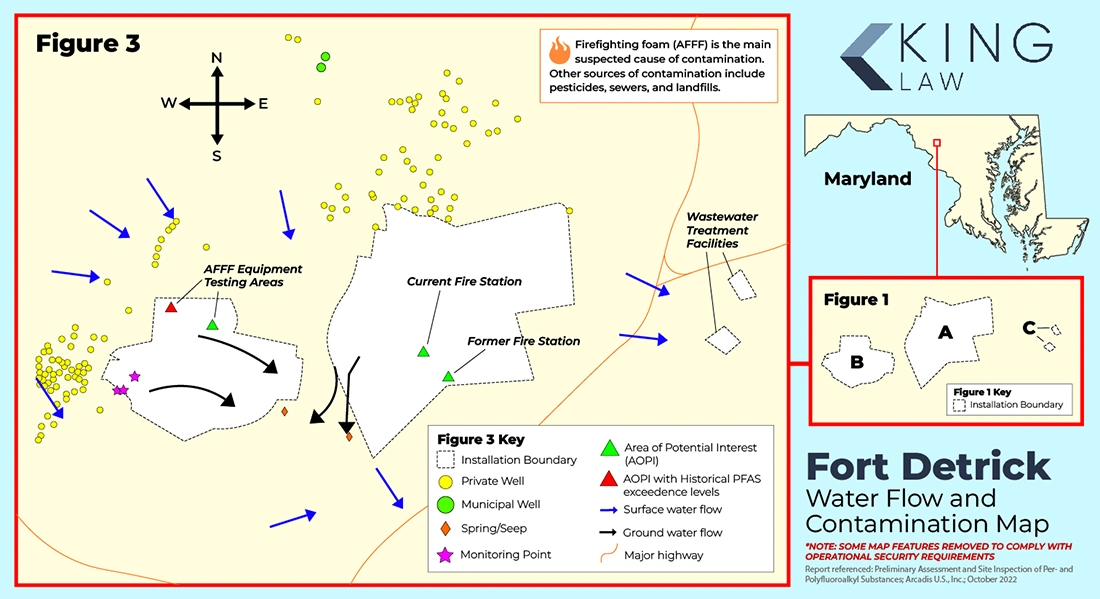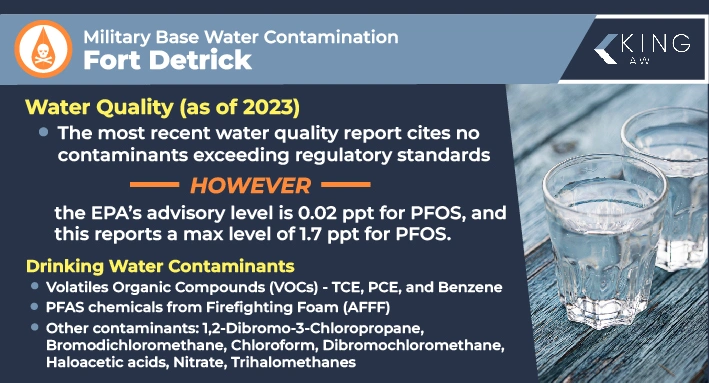
Fort Detrick Water Contamination Lawsuit Overview
Fort Detrick began as a small emergency airfield called Detrick Field. It was home to the 104th Observation Squadron of the Maryland National Guard in the 1930s before it was expanded and upgraded to then take on a larger role to train the 2nd Bombardment Squadron during World War II. Detrick Field was transferred to the Army in 1943 and renamed Camp Detrick. It became the base for the U.S. Army Biological Warfare Laboratories (USBWL) in response to the country’s fears of bioweapons and its lack of defense against them. Since 1943, Fort Detrick has been dedicated to bioweaponry, biodefense, and numerous public health missions.
Unfortunately, Fort Detrick military personnel and their families could have been exposed to toxic drinking water. One is PFAS, a chemical derived from Aqueous Film Forming Foam (AFFF), a firefighting foam used at military bases for decades. This contaminated soil, groundwater, and drinking water with PFAS. Other contaminants include TCE and PCE, industrial agents used for practices like degreasing. Exposed individuals are at risk of developing illnesses like testicular cancer, kidney cancer, thyroid cancer, ulcerative colitis, and thyroid disease. If you or a loved one were exposed and developed a related condition, you may be entitled to compensation through a Fort Detrick water contamination lawsuit.
Fort Detrick Water Contamination Lawsuit Updates
April 9, 2024: Superfund Report Highlights Contamination at Fort Detrick’s Area B
Superfund report on Fort Detrick details base contamination. The report indicates that “Area B” has a particular history of contamination. Area B, located in Frederick, Maryland, has a history of use in testing biological weapons. The area was then used as a dumping ground for chemicals and radiological material. Decontamination began as early as the 1970s. There has been significant testing of the groundwater at Fort Detrick. TCE and PCE have been detected in the groundwater. Fort Detrick was added to the National Priorities List on September 3, 2008. There are at least four known contamination sites. Monitoring of the contamination at Fort Detrick is ongoing.
March 2024: Claimants Seek Compensation Through Fort Detrick Water Contamination Lawsuits
Thousands of victims across the United States are filing lawsuits against chemical manufacturers after being exposed to toxins at military bases like Fort Detrick. Fort Detrick water has tested positive for PFAS, TCE, PCE, and other toxins that can lead to illnesses like testicular cancer, kidney cancer, thyroid cancer, liver cancer, and thyroid disease.
On this page:
History of Toxic Exposure at Fort Detrick
Fort Detrick Water Contamination Map
Contaminants and Chemicals Found in Fort Detrick’s Water
Current Water Quality at Fort Detrick
Health Risks and Symptoms Linked to Drinking Water at Fort Detrick
Eligibility Criteria for Filing a Fort Detrick Water Contamination Lawsuit
Fort Detrick Water Contamination Settlement and Payout Amounts
How to File a Fort Detrick Water Contamination Lawsuit
History of Toxic Exposure at Fort Detrick
Fort Detrick has a long history with contaminated drinking water. PFAS, TCE, PCE, and other VOCs have been of particular concern, especially when they’ve exceeded regulatory standards. Regular testing of water at and around Fort Detrick is done to monitor toxicity.
Keep in mind that while PFAS limits used to be set at 70 ppt, the EPA has since lowered their advisories to 0.004 ppt for PFOA and 0.02 ppt for PFOS.
February 2023 – Low Levels of PFAS Detected in Drinking Water
According to 2023 water quality reports, low levels of two PFAS chemicals were detected in drinking water during a February 2023 sample. This includes PFOS at 1.7 ppt and PFBS at 1.9 ppt. While both levels were below the Maximum Contaminant Level (MCL), the EPA released updated advisories in 2022 that put the acceptable level of PFOS at 0.02 ppt. The 1.7 ppt sample result is 85 times that advisory.
November 2022 – PFAS Still Present in Fort Detrick Drinking Water
According to a 2022 water quality report, Fort Detrick drinking water still tested positive for PFAS including PFOS at 2.6 ppt, PFOA at 2.6 ppt, PFHxA at 2.4 ppt, and PFBS at 2.0 ppt.
September 2022 – Wells Test Positive for Trichloroethene and Chloroform
Groundwater testing at wells SW-1 and SW-33 revealed trichloroethene and chloroform levels above screening criteria. Nine wells also raised concerns of unacceptable risk of vapor intrusion, which is when volatile chemicals in groundwater evaporate and cause air contamination. This has also been a concern at Camp Lejeune.
July 2020 & September 2020 – Fort Detrick Water Tests Positive for PFOS and PFOA
PFOS and PFOA were found in Fort Detrick water according to a 2020 water quality report. July 2020 and September 2020 samples tested with a maximum of 4.2 ppt for PFOS and 2.7 ppt for PFOA. Trihalomethanes also exceeded regulatory limits.
November 2010 – Maryland Senator Demands Cleanup From Fort Detrick Contamination
People living near Fort Detrick, including local advocacy groups, spoke to news agencies demanding the federal government prioritize cleanup of contamination from the military base. They referenced drinking contaminated water and experiencing high rates of cancer. Maryland’s Senator, Ben Cardin, also expressed anger. According to CBS News, he said, “The first thing to do is make sure it’s safe. We don’t want anyone living or working where it’s not safe. The federal government has to take responsibility.”
2001-June 2004 – Waste Pits Removed That Contributed to TCE and PCE Contamination
Area B-11 of the Fort Detrick base had waste pits where the military had disposed of hazardous materials, contributing to TCE and PCE contamination of soil and groundwater. From 2001 through June 2004, the Army performed an interim removal action (IRA) to get rid of the chemical waste pits.
Fort Detrick Water Contamination Map

Review the Fort Detrick contamination map to understand the sources and spread of toxic water throughout the base. Contamination can originate at training fields and storage facilities, enter groundwater, and end up in drinking water.
Contaminants and Chemicals Found in Fort Detrick’s Water
Fort Detrick water quality reports have confirmed the presence of different contaminants, including TCE, PCE, and PFAS. Each toxin has its own set of risks, including cancer. Veterans, their family members, and residents living near Fort Detrick are at risk of serious health conditions related to drinking and using contaminated water.
Per- and Poly-fluoroalkyl Substances (PFAS)
PFAS is a group of chemicals associated with numerous severe health ailments, such as bladder cancer, breast cancer, non-Hodgkin’s lymphoma, kidney cancer, leukemia, liver cancer, multiple myeloma, thyroid disease, ulcerative colitis, reduced vaccine efficacy, and additional conditions.
This group of chemicals is frequently found in firefighting foam, a substance extensively utilized by the military since the 1940s. As the firefighting foam entered the ground, it contaminated groundwater and spread into drinking water supplies. Many veterans are now filing PFAS lawsuits to hold chemical manufacturers responsible for their exposure.
Volatile Organic Compounds (VOCs)
VOCs are chemicals that can vaporize into the air or dissolve in water. They frequently end up in groundwater and migrate into wells that supply drinking water. Long-term exposure and exposure to VOCs at high levels can increase your risk of cancer and cause kidney, liver, immune system, and nervous system issues.
Fort Detrick has had long-standing concerns with VOCs, particularly at Area B. A study published in 2023 noted that 13 VOCs were detected at Area B that exceeded the EPA’s MCLs. Some of these VOCs included:
- TCE: A chemical primarily from industrial cleaners used to degrease metal parts, TCE has been associated with various forms of cancer, such as kidney cancer, liver cancer, and lymphoma.
- PCE: Commonly stemming from the use of industrial solvents including degreasers and paint thinners, PCE is linked to bladder cancer, non-Hodgkin’s lymphoma, and multiple myeloma.
- Benzene: Often originating from solvents, jet fuel, and as a byproduct of waste disposal at military sites, benzene exposure can result in leukemia and other blood-related cancers.
Other Contaminants
The Environmental Working Group (EWG) Tap Water Database lists a series cancer-related contaminants that exceeded its Health Guidelines from 2014-2019 at Fort Detrick:
- 1,2-Dibromo-3-chloropropane (DCBP): 2.9x EWG Health Guideline
- Bromodichloromethane: 139x EWG Health Guideline
- Chloroform: 65x EWG Health Guideline
- Dibromochloromethane: 9.3x EWG Health Guideline
- Haloacetic acids (HAA5): 400x EWG Health Guideline
- Nitrate: 17x EWG Health Guideline
- Trihalomethanes (TTHMs): 381x EWG Health Guideline
Current Water Quality at Fort Detrick
The most recent drinking water quality report for Fort Detrick cites no contaminants exceeding regulatory standards. However, the EPA’s health advisory is 0.02 ppt for PFOS, and the 2023 report cites a maximum level of 1.7 ppt for PFOS. Levels of haloacetic acids were close to the MCL, and not all previous contaminants of concern were included in this report.
Regardless of current levels, thousands of military personnel, family members, and civilians were exposed to drinking water with contamination levels above health advisories, putting them at risk of several cancers and other illnesses.

Water Treatment Efforts at Fort Detrick
Fort Detrick drinking water has undergone traditional water filtration and treatment methods over the years with the exception of a new ultraviolet disinfection system in 2016. From September 2012-December 2020, Fort Detrick had an agreement with Frederick County to purchase safe drinking water. This agreement has since ended.
Officials have long followed the 70 ppt PFAS limit when deciding when to take action, so PFAS has been left unaddressed in Fort Detrick water when below this threshold. However, the EPA has established new health advisories for PFOA at 0.004 ppt and for PFOS at 0.02 ppt, which were significantly lower than the original 70 ppt standard.
Health Risks and Symptoms Linked to Drinking Water at Fort Detrick
We are presently examining instances of testicular cancer, thyroid cancer, kidney cancer, and thyroid disease among those affected by contaminated drinking water containing chemicals such as PFAS, TCE, and PCE. Other health risks and symptoms from exposure to Fort Detrick water may include a compromised immune response, reduced vaccine efficacy, ulcerative colitis, and symptoms indicative of various cancers like liver, kidney, and others.
Our law firm is currently evaluating cases where individuals have been diagnosed with:
- Kidney Cancer
- Liver Cancer
- Prostate Cancer
- Testicular Cancer
- Thyroid Cancer & Thyroid Disease
- Ulcerative Colitis
It is imperative to inform your healthcare provider about your exposure to ensure proper monitoring, screening, and prompt treatment. Seek medical attention as soon as possible should any adverse health effects arise.
Eligibility Criteria for Filing a Fort Detrick Water Contamination Lawsuit
You may be eligible to file a Fort Detrick water contamination lawsuit if you were exposed to toxic drinking water and have developed a related health condition. Eligibility criteria includes:
- Duration of exposure: We are typically looking for at least 6 months of toxic exposure to contaminants like PFAS at a military base. Long-term, high levels of exposure may build a strong case.
- Diagnosis: You must have a diagnosed health condition related to exposure at Fort Detrick. We are currently accepting cases with diagnoses of kidney cancer, testicular cancer, thyroid cancer, thyroid disease, and other illnesses.
Our law firm is currently evaluating cases where individuals have been diagnosed with:
- Kidney Cancer
- Liver Cancer
- Prostate Cancer
- Testicular Cancer
- Thyroid Cancer
- Thyroid Disease
- Ulcerative Colitis
Collect any documentation, such as medical records and military orders, to confirm your eligibility and give your attorney the information needed to build a successful case.
Fort Detrick Water Contamination Settlement and Payout Amounts
We predict Fort Detrick water contamination settlements could result in payouts ranging from $100,000 to $300,000. Actual payouts can vary depending on the specifics of your case. Cases that lack substantiation may resolve on the lower end at $30,000-$75,000. Cases with strong substantiation may reflect higher amounts such as $500,000-$1,000,000. Reach out to one of our attorneys today to review your case and help you understand your compensation potential.
How to File a Fort Detrick Water Contamination Lawsuit
Attorneys with experience handling toxic torts and environmental litigation can provide the support you need to understand the process for filing an exposure lawsuit. This process typically entails:
- Confirm you meet eligibility requirements to file a water contamination lawsuit, including at least 6 months of exposure and a diagnosis of a related health condition.
- Reach out to an attorney for a consultation so they can review the details of your case and begin the filing process.
- Provide your attorney with as much documentation as possible to prove your time stationed at Fort Detrick, development of a contamination-related illness, and resulting issues such as medical costs and lost wages.
- Your attorney will file your case with the appropriate court and contact you with any additional requests for information.
- Ideally, your case will result in a settlement where your attorney can negotiate on your behalf. In some cases, they may recommend going to court, though this could result in no compensation if the ruling is not in your favor.
It can take several months or more for a successful water contamination lawsuit to pay out. Your attorney will help you understand what to expect and can help you understand deadlines for filing. However, it’s critical to seek legal counsel as soon as possible to help ensure you don’t miss your opportunity for compensation.
Evidence to Support Your Fort Detrick Claim
To build a strong Fort Detrick water contamination claim, you will need substantial evidence, such as:
- Proof you were at Fort Detrick such as military directives or discharge paperwork
- Proof of exposure to toxins when you were at Fort Detrick
- Medical records detailing your related diagnosis
- Additional documentation with information about your prognosis, recommended treatments, and associated medical costs
Expert testimonies, environmental studies, and other reliable information citing the connection between the toxin you were exposed to and your illness
Fort Detrick Water Contamination Lawyers
To ensure your best opportunity at building a strong case and earning the full amount of compensation you’re entitled to, you should utilize attorneys experienced in mass tort cases and environmental exposure litigation like those at King Law. We have the background and expertise needed to advocate on your behalf and are available to support you throughout the entire process. Contact us today to schedule a consultation.
Frequently Asked Questions (FAQs)
Keep reading for additional answers to commonly asked questions about Fort Detrick drinking water.

